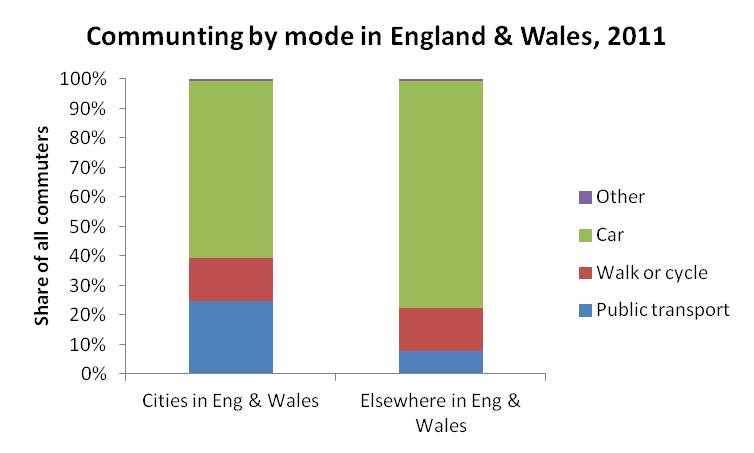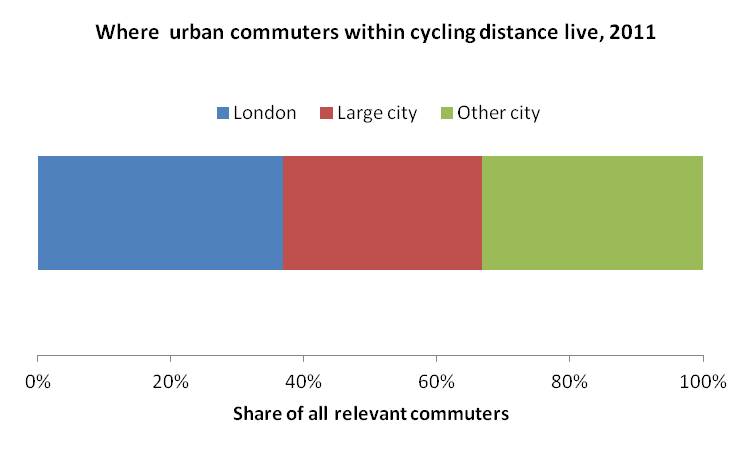But how realistic is it?
POINT 1: Nearly 2/3rds of commuters in England & Wales live within realistic walking or cycling distance to work.
 https://abs.twimg.com/emoji/v2/... draggable="false" alt="🚴♂️" title="Man biking" aria-label="Emoji: Man biking"> 9.3m - 43% of commuters - live within 5km of work (walking distance)
https://abs.twimg.com/emoji/v2/... draggable="false" alt="🚴♂️" title="Man biking" aria-label="Emoji: Man biking"> 9.3m - 43% of commuters - live within 5km of work (walking distance)
 https://abs.twimg.com/emoji/v2/... draggable="false" alt="🚴♂️" title="Man biking" aria-label="Emoji: Man biking"> 13.9m - 64% - live within 10 km (cycling distance).
https://abs.twimg.com/emoji/v2/... draggable="false" alt="🚴♂️" title="Man biking" aria-label="Emoji: Man biking"> 13.9m - 64% - live within 10 km (cycling distance).
That& #39;s a lot of people.
That& #39;s a lot of people.
POINT 2: But switching to cycling or walking *outside* of cities won& #39;t make a lot of difference to congestion.
 https://abs.twimg.com/emoji/v2/... draggable="false" alt="🚗" title="Automobile" aria-label="Emoji: Automobile"> Outside of urban areas in England & Wales, 5% of commuters use public transport.
https://abs.twimg.com/emoji/v2/... draggable="false" alt="🚗" title="Automobile" aria-label="Emoji: Automobile"> Outside of urban areas in England & Wales, 5% of commuters use public transport.
Post lockdown there& #39;ll be very little extra pressure on the network here.
Post lockdown there& #39;ll be very little extra pressure on the network here.
POINT 3: And even in many cities not many people use public transport either.
 https://abs.twimg.com/emoji/v2/... draggable="false" alt="🌇" title="Sunset over buildings" aria-label="Emoji: Sunset over buildings"> In 27 cities, fewer than 1 in 10 use public transport.
https://abs.twimg.com/emoji/v2/... draggable="false" alt="🌇" title="Sunset over buildings" aria-label="Emoji: Sunset over buildings"> In 27 cities, fewer than 1 in 10 use public transport.
 https://abs.twimg.com/emoji/v2/... draggable="false" alt="🚗" title="Automobile" aria-label="Emoji: Automobile"> In Telford it& #39;s 5%.
https://abs.twimg.com/emoji/v2/... draggable="false" alt="🚗" title="Automobile" aria-label="Emoji: Automobile"> In Telford it& #39;s 5%.
 https://abs.twimg.com/emoji/v2/... draggable="false" alt="🚋" title="Tram car" aria-label="Emoji: Tram car"> In London it& #39;s 45%
https://abs.twimg.com/emoji/v2/... draggable="false" alt="🚋" title="Tram car" aria-label="Emoji: Tram car"> In London it& #39;s 45%
See here: #graph=table&city=show-all&indicator=commuting-by-bus-train-or-metro">https://www.centreforcities.org/data-tool/ #graph=table&city=show-all&indicator=commuting-by-bus-train-or-metro\\single\\2011&tableOrder=tableOrder\\1,0">https://www.centreforcities.org/data-tool...
See here: #graph=table&city=show-all&indicator=commuting-by-bus-train-or-metro">https://www.centreforcities.org/data-tool/ #graph=table&city=show-all&indicator=commuting-by-bus-train-or-metro\\single\\2011&tableOrder=tableOrder\\1,0">https://www.centreforcities.org/data-tool...
POINT 4: In those cities where more than 1 in 10 use public transport:
 https://abs.twimg.com/emoji/v2/... draggable="false" alt="🚶♀️" title="Woman walking" aria-label="Emoji: Woman walking"> 5.5 million live in walking distance
https://abs.twimg.com/emoji/v2/... draggable="false" alt="🚶♀️" title="Woman walking" aria-label="Emoji: Woman walking"> 5.5 million live in walking distance
 https://abs.twimg.com/emoji/v2/... draggable="false" alt="🚴♂️" title="Man biking" aria-label="Emoji: Man biking">8.5 million in cycling distance.
https://abs.twimg.com/emoji/v2/... draggable="false" alt="🚴♂️" title="Man biking" aria-label="Emoji: Man biking">8.5 million in cycling distance.
This is the more realistic pool of people the Government is talking about.
This is the more realistic pool of people the Government is talking about.
POINT 5: Of the 8.5m potential walkers or cyclists, 37% live in London, and 68% live in London or large cities.
So the Government& #39;s push is principally one aimed at London, and to a lesser extent large cities such as Manchester.
So the Government& #39;s push is principally one aimed at London, and to a lesser extent large cities such as Manchester.
POINT 6: Of course, this is a potential number. Some will walk or cycle already. And while some will switch to feet or 2 wheels, many will not.
So while I hope people will switch, for congestion & environmental reasons, realistically it& #39;s not going to be that many.
ENDS
So while I hope people will switch, for congestion & environmental reasons, realistically it& #39;s not going to be that many.
ENDS
@GraemePaton this may be of interest

 Read on Twitter
Read on Twitter 9.3m - 43% of commuters - live within 5km of work (walking distance)https://abs.twimg.com/emoji/v2/... draggable="false" alt="🚴♂️" title="Man biking" aria-label="Emoji: Man biking"> 13.9m - 64% - live within 10 km (cycling distance). That& #39;s a lot of people." title="POINT 1: Nearly 2/3rds of commuters in England & Wales live within realistic walking or cycling distance to work. https://abs.twimg.com/emoji/v2/... draggable="false" alt="🚴♂️" title="Man biking" aria-label="Emoji: Man biking"> 9.3m - 43% of commuters - live within 5km of work (walking distance)https://abs.twimg.com/emoji/v2/... draggable="false" alt="🚴♂️" title="Man biking" aria-label="Emoji: Man biking"> 13.9m - 64% - live within 10 km (cycling distance). That& #39;s a lot of people." class="img-responsive" style="max-width:100%;"/>
9.3m - 43% of commuters - live within 5km of work (walking distance)https://abs.twimg.com/emoji/v2/... draggable="false" alt="🚴♂️" title="Man biking" aria-label="Emoji: Man biking"> 13.9m - 64% - live within 10 km (cycling distance). That& #39;s a lot of people." title="POINT 1: Nearly 2/3rds of commuters in England & Wales live within realistic walking or cycling distance to work. https://abs.twimg.com/emoji/v2/... draggable="false" alt="🚴♂️" title="Man biking" aria-label="Emoji: Man biking"> 9.3m - 43% of commuters - live within 5km of work (walking distance)https://abs.twimg.com/emoji/v2/... draggable="false" alt="🚴♂️" title="Man biking" aria-label="Emoji: Man biking"> 13.9m - 64% - live within 10 km (cycling distance). That& #39;s a lot of people." class="img-responsive" style="max-width:100%;"/>
 Outside of urban areas in England & Wales, 5% of commuters use public transport. Post lockdown there& #39;ll be very little extra pressure on the network here." title="POINT 2: But switching to cycling or walking *outside* of cities won& #39;t make a lot of difference to congestion. https://abs.twimg.com/emoji/v2/... draggable="false" alt="🚗" title="Automobile" aria-label="Emoji: Automobile"> Outside of urban areas in England & Wales, 5% of commuters use public transport. Post lockdown there& #39;ll be very little extra pressure on the network here." class="img-responsive" style="max-width:100%;"/>
Outside of urban areas in England & Wales, 5% of commuters use public transport. Post lockdown there& #39;ll be very little extra pressure on the network here." title="POINT 2: But switching to cycling or walking *outside* of cities won& #39;t make a lot of difference to congestion. https://abs.twimg.com/emoji/v2/... draggable="false" alt="🚗" title="Automobile" aria-label="Emoji: Automobile"> Outside of urban areas in England & Wales, 5% of commuters use public transport. Post lockdown there& #39;ll be very little extra pressure on the network here." class="img-responsive" style="max-width:100%;"/>



